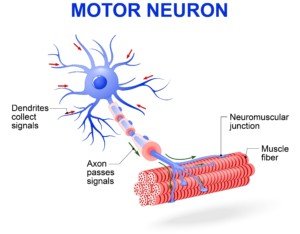Twitching muscles (fasciculations) are very common.
Every man and woman experiences muscle twitching.
Twitching muscles are most often in the legs, but twitching can occur in the facial, neck, chest and even back muscles.
Almost any muscle can have a fasciculation.
But this usually goes unnoticed unless it’s excessive, and/or the muscle twitching causes an entire finger or toe to “jump.”
Also, a fasciculation can often be clearly seen when it happens, especially if it occurs in the quadriceps, chest or face.
Muscle twitching means things are more normal than abnormal.

Shutterstock/Designua
Anxiety
“I would have to say in my small world, anxiety does often come up as a potential cause in many,” says Reena Patel, MD, a board certified family medicine physician who treats patients at Garnet Health Urgent Care in NY.
“The flipside is this can be a medication or medical condition effect as well.
“But focusing on anxiety, we can explore why this may be happening.
“Anxiety in general is a heightened energy associated state. In fact, when we treat it we use ‘calming’ techniques or medicine.
“When we have anxiety, our body releases messengers or neurotransmitters without known cause — which in turn cause these muscle movements when we are anxious.
“Research also connects anxiety with breathing faster, which we know alters your pH and can result in muscle twitching as well.
“A good history will sometimes point to some identifiable etiology.”
Benign Fasciculation Syndrome
Anxiety and stress are often the chief culprit in relentless twitching, and when accompanied by cramping and/or stiffness and some exercise intolerance, the condition is called benign fasciculation syndrome.
Benign means the situation will not develop into anything serious.
But these other symptoms often come on after the person starts excessively worrying that the muscle twitching is a sign of a deadly disease.
Anxiety makes muscles twitch. It’s that simple.
One theory is that in ancient times, early man had to always be ready for action, living in a harsh environment with no modern-day conveniences to protect him.
His muscles and his entire nervous system had to always be prepared for a fight with danger, or for an escape from danger.
We are genetically hardwired to physiologically react to a crisis situation.
Our muscles are on standby to jump into action. But contemporary stress is different from ancient stress.
Today, we don’t need to be ready for the charging bison or hissing snake.
But just the same, our bodies are under siege by other forms of anxiety:
Workplace stress, paying bills, marital problems, dealing with the in-laws, traffic jams, driving through snowstorms, tense business meetings, conflicts with the neighbor, etc. It’s no wonder that our muscles are always jumping.
When we are under chronic or acute stress, our muscles twitch because they think that at any moment, action will be required of them.

Shutterstock/tommaso79
So they are, in a sense, gearing up for the fight or flight, kind of like a track sprinter dragging his foot backward on the track as he prepares for the race.
Anxiety tells the muscles, “Get ready. On your mark, get set…”
But the “go” never happens, because modern-day stress is not of a life-threatening nature (such as a charging bison, falling rock or hissing snake).
So the muscles remain in idle, like a car at a stop light. The engine is on, but the car goes nowhere.
The engine, in this case, is the muscles twitching. They are not relaxed. They are anticipating.
So when you notice a lot of muscle twitching while under stress or waves of anxiety, you should realize that this means that everything is very likely working just fine.
In addition to treating many chronic conditions, Dr. Patel treats urgent conditions that affect every part of the body. Instagram: That_dr_next_door
 Lorra Garrick has been covering medical, fitness and cybersecurity topics for many years, having written thousands of articles for print magazines and websites, including as a ghostwriter. She’s also a former ACE-certified personal trainer.
Lorra Garrick has been covering medical, fitness and cybersecurity topics for many years, having written thousands of articles for print magazines and websites, including as a ghostwriter. She’s also a former ACE-certified personal trainer.
.











































